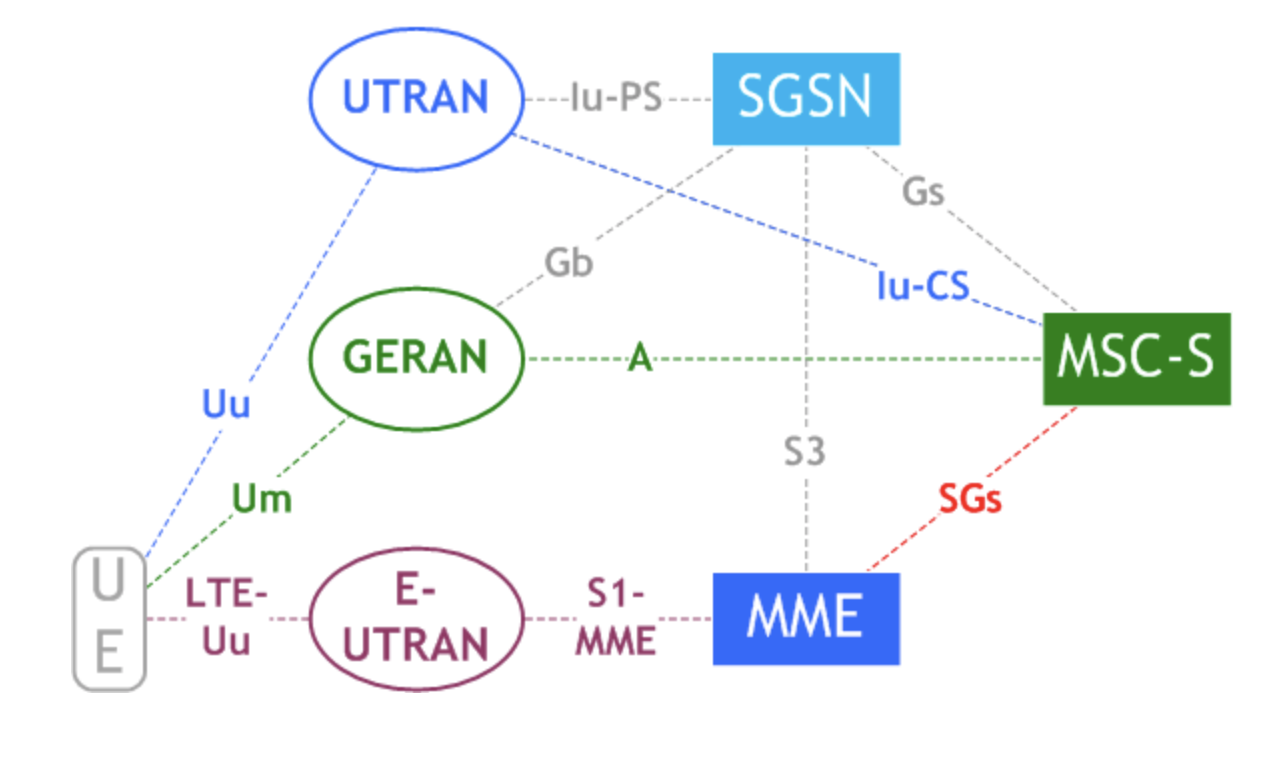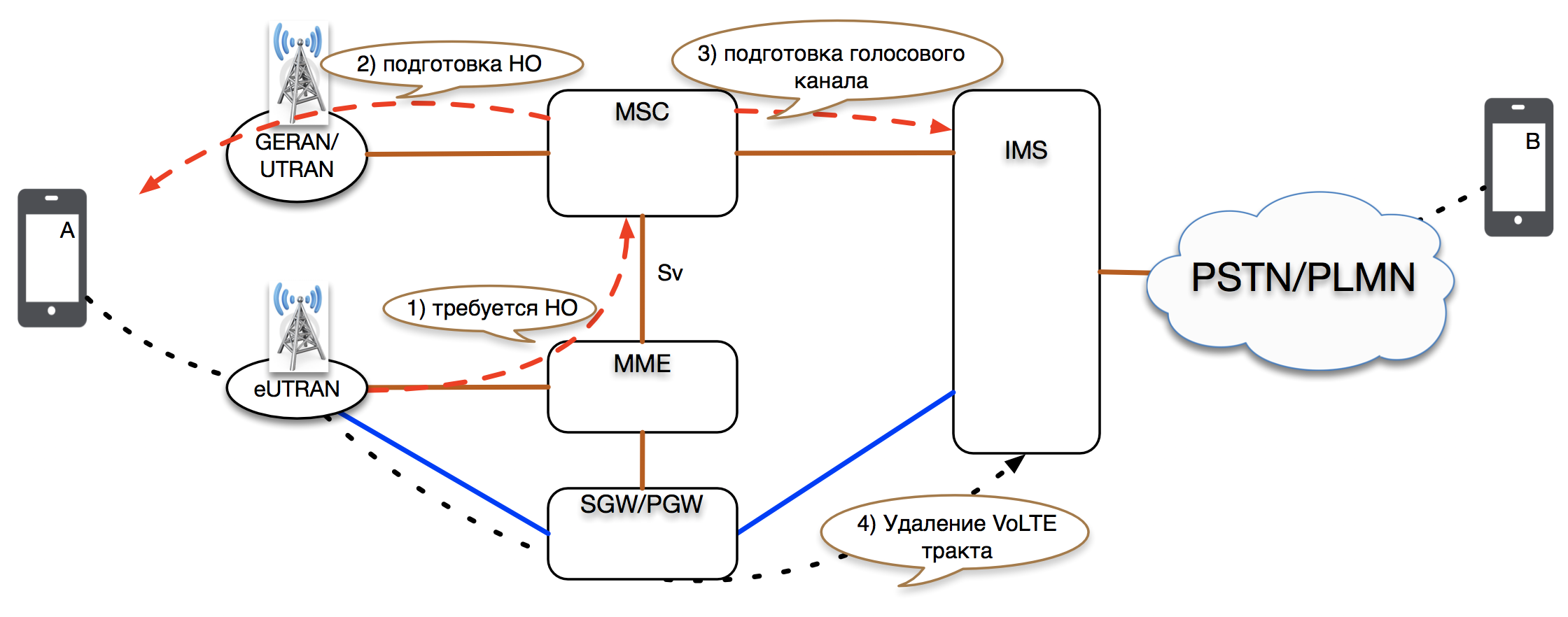VoLTE / ViLTE + Wi-Fi-Calling - just about complicated
Today we will talk about new enough for Russia technologies of voice and video transmission in the network of the cellular operator - VoLTE (Voice over LTE) , ViLTE (Video over LTE) and Wi-Fi-Calling (WFC).

Why does the phone go to the 3G network when calling from the LTE network?
Before proceeding to the consideration of new technologies, let's refresh in the memory of how our smartphone currently works on the 4G / LTE network.
I think that many subscribers noticed that the smartphone during incoming or outgoing calls goes to the network of the previous generation (2G / 3G), and the connection itself takes a lot of time. To begin with, a few words should be said about how the network of the mobile operator looks at the highest level (very large blocks).

At first glance, it is not difficult, but it is only at first. Let's figure it out.
As can be seen in the picture above, the radio access network of the second (2G, or GERAN) and third (3G, or UTRAN) generations is connected to both the channel switching core (CS Core) for voice calls and the packet switching core (PS Core ) to access IP networks and to access the Internet. The logical conclusion that arises from the above: CS Core provides voice communication, and PS Core is designed to transfer data. We will not stop to analyze how data and voice networks work within the framework of this article.
Consider the passage of voice calls for a 4G network. Before diving into the details, let's take another look at the picture and recall that the LTE radio access network does not have direct connections to CS Core. At first glance, this is strange, but there is a solution. And part of the solution is the interface between PS Core and CS Core, which is called SGs .
(It is fair to say that even before the introduction of the 4G / LTE standard, the connection between the channel and packet core was possible. The interface over which this communication could take place is called Gs . The tasks assigned to the Gs interface were to combine (combine) procedures registration in both domains, as well as in ensuring the search for a device (paging) that was carried out from the channel domain to the packet domain. This made it possible to suspend data transmission in the 2G network and receive voice calls.)
In the 4G / LTE network, the SGs interface is no longer optional and plays an important role. We recall that in the LTE network our mobile device works only in the packet domain (PS Core) and, as you already guessed, we cannot do without an interface between PS and CS Core.

Now let's take a quick look at the process of making voice calls when your device is on an LTE network. Without going deep into the technical did, this can be explained as follows:
Incoming call. Since the phone is in the LTE network and does not have the ability to “listen” to the 2G / 3G network, it can only be “reached” using the 4G network. For the mobility in the LTE network, the network element MME (Mobility Management Entity) is responsible. It is through this device that via the SGs interface the mobile switch (MSC-S) searches for a smartphone using the “paging” procedure with an indicator that an incoming call is in progress, signaling that the phone needs to go to the previous generation network with re-registration in the CS domain and receive the call.
Outgoing call. The mobile device informs the base station (eNodeB) that it is going to make an outgoing call, thereby starting the transition process from LTE to the network of the previous generation. It is impractical to describe the procedure in more detail in this article.
The transition process from LTE to the previous generation network for making voice calls is called CS Fallback (CSFB).
Upon completion of the call (no matter incoming or outgoing), the device will return to the LTE network, but with a small “BUT”. Despite the fact that the device had to re-register on the 3G network (less often in 2G), data transmission, which could have been made before the call, can be carried out simultaneously with the voice call. At the same time, the mobile device will not lose the IP address allocated to it. "BUT" is that the transition to the LTE network will occur only in the nearest pause in data transfer.
(A small note about SMS. In the LTE network, both incoming and outgoing SMS are transmitted via the same SGs interface and there are no transitions between networks of different generations.)
Voice over LTE (VoLTE) and Video over LTE (ViLTE)
The LTE network, in comparison with previous generations of the network, has better latency and RTT indicators , and it is well suited for traffic that is critical to the quality of the transmission channel, namely, unbuffered voice and video, which are our calls. Making voice calls is finally moving to the IP protocol directly from the mobile device.
Now let's look at what has changed in the operator's network architecture.

We see that, compared with the previous scheme, a little cloud was added with the name IMS . Yes, indeed, IMS was chosen as the core for voice calls support for the LTE network and Wi-Fi.
Let's start with the registration process. The mobile device must ensure that the operator’s network supports voice over IP in a specific radio coverage area. If this is the case, the smartphone tries to activate bearer (communication channel by IP) with a special APN and with a dedicated QCI-5 class of service, which is reserved and optimized for IMS-signaling. This class of service has a higher priority than the class of service for data transmission, which is used to access the Internet, but, like the Internet, it does not require a guaranteed data transmission band and is less critical for delays than for voice and video. Upon completion of the bearer activation process, the mobile device has an IP address, and the network reported the IP address of the P-CSCF, which is already the first element of the IMS core.
It is impractical to dwell in detail on the processes that occur in the depths of the network within the framework of this article. If desired, this information can be found on the resources listed in the end of the article. I will give only a picture with the main elements of PS Core and IMS.

The mobile device has registered with the IMS core and can now make voice calls, send / receive SMS.
One of the main distinguishing features of a mobile VoLTE network from classic SIP telephony is the bandwidth control for a specific type of traffic. It is no secret that when transmitting voice traffic over IP networks there is always a risk of packet loss, which is detrimental to speech intelligibility. In order to ensure acceptable quality, IP labeling technology is used. Transport equipment with an “understanding” refers to tagged packets, tries to prevent their loss and ensures their priority transfer to hop-by-hop. In a mobile operator’s network, one of the most expensive resources is a radio resource and there is always a chance that it may not be available in the zone of the required base station (eNodeB) for voice call, because all of them are used to transmit data from the Internet. I already mentioned that for registration, the mobile device activated a separate bearer with QCI-5, which is higher in terms of service than the bearer for the Internet and has a SIP session with IMS Core. When establishing a voice call - no matter incoming or outgoing - the IMS core via PCRF and the packet switching core requests an additional dedicated radio resource (dedicated bearer) with a guaranteed bit rate and with QCI-1 in order to send an RTP stream with selected codec. This resource already has the highest priority, which ensures the necessary quality of speech. incoming or outgoing - the IMS core via PCRF and the packet switching core requests an additional dedicated radio resource (dedicated bearer) with a guaranteed bit rate and with QCI-1 in order for the RTP stream with the selected codec to be transmitted in it. This resource already has the highest priority, which ensures the necessary quality of speech. incoming or outgoing - the IMS core via PCRF and the packet switching core requests an additional dedicated radio resource (dedicated bearer) with a guaranteed bit rate and with QCI-1 in order for the RTP stream with the selected codec to be transmitted in it. This resource already has the highest priority, which ensures the necessary quality of speech.
Now we can mention such technology as Video over LTE (ViLTE). Everything that was said for VoLTE is also true for ViLTE. To connect the video stream in the same way as for the voice, another dedicated bearer is requested. It also requires a guaranteed band with a slightly higher bandwidth than voice, but already with a slightly lower priority (QCI-2). The decrease in priority is due to the fact that the loss of packets for a video stream is no longer so critical than for a voice one. Agree that speech intelligibility is much more important than a short-term failure in the transfer of pictures. As a result, in the case of ViLTE, the smartphone has three bearers for the needs of IMS (QCI-5 is an alarm system, QCI-1 is a voice channel, QCI-2 is a video channel).
I would also like to briefly touch on the topic of handovers (transitions from the network of one generation to another). Today, LTE network coverage is inferior to previous generation network coverage. In order for the conversation not to be interrupted if the signal level of the LTE network falls below the threshold level, the phone will have to be re-registered in the channel switching core (CS Core). SRVCC (Single Radio Voice Call Continuity) technology has been developed to ensure the “seamlessness” of such a transition. Unlike CS Fall Back (CSFB), which was considered in the first part of the article, at the time of the transition from LTE to the network of the previous generation, we already have a voice call, which we are trying to save without interruption. The technology is based on the GTPv2 protocol and an additional interface between the PS Core and CS Core, which is called Sv. To ensure the operation of this interface, CS Core has undergone refinement, which previously did not support the GTP protocol (GPRS tunneling protocol). Schematically, the transition from VoLTE to CS-call is shown in the figure.

Now we can say a few words about what is useful in VoLTE and why this technology is being introduced:
- VoLTE allows not to switch from the LTE network to the network of the previous generation, which speeds up the process of making a voice call;
- the phone remains in LTE, and data transmission can continue without speed reduction;
- There are no strict restrictions on the transmission band, which allows to provide high quality voice (HD-Voice);
- There is an opportunity to make video calls, and subsequently video conferences;
- under the IMS core, it is possible to implement additional services, such as Push-to-Talk .
VoWi-Fi, or Wi-Fi-Calling, or WFC
The fundamental difference between VoWi-Fi and VoLTE is that the usual Wi-Fi is used as the “last mile”. This can be a home Internet and public Wi-Fi of a cafe. The same IMS is used as the network core, but there are some minor changes in the access network part. Let's look at the picture.

The attentive reader will notice that there are no major differences from the PS Core scheme for VoLTE. Still, the core of packet switching and IMS Core is through the SGi interface from PGW. The changes affected the path of traffic from the mobile device to the packet switching core. To do this, we have a device called ePDG. That is, it has direct access to the Internet, and it will be to it that, first of all, phones will be connected using the usual IPSec protocol. Before registering with the IMS core, as before, you need to successfully register with the packet switching core. This time registration is done not from MME, but from ePDG. The SWm interface is used for this, and we see another network element called AAA. The peculiarity of the AAA node involved in the registration process from untrusted Wi-Fi, that is, from the Internet, is that it does not work on the usual many Radius protocol, but on its upgraded version - the Diameter protocol. Further, as in the LTE network, authentication and verification of the availability of the corresponding services is performed in the same HSS (Home Subscriber Server).
After passing the registration in the packet core and the subsequent registration in the IMS Core, calls are made in the same way as from VoLTE.
From the main technological issues, it remains for us to consider the transition (Handover) from the Wi-Fi network to VoLTE and back.
It's no secret that Wi-Fi networks have a very small range. In order for our voice calls not to be interrupted when the Wi-Fi network is lost, the mobile device constantly monitors the signal level, and if it falls below the threshold level, a transition is made to the LTE network. If you look at the previous scheme once again, it becomes clear that when switching to the LTE network, it is quite possible to remain at the same PGW that was used for Wi-Fi-Call. And the S6b interface helps in this .which, using the AAA server, tells the HSS the PGW address on which the registration was made from the Wi-Fi network. With this transition, the session on the PGW is saved with the same IP address that was allocated during registration via the Wi-Fi network. As a result, we get almost seamless Handover VoWi-Fi -> VoLTE. The reverse transition is carried out according to the same rules.
As at the end of the previous part, a few words about what is useful in VoWi-Fi and why this technology is being introduced:
- an opportunity to make and receive voice calls with your mobile phone number from any place where there is Internet access via Wi-Fi without using third-party applications;
- Wi-Fi-Calling allows you to make calls from a Wi-Fi network around the world at a home rate.
Questions and answers
I foresee that there will be a number of questions and I will try to answer them in advance:
Q: In which regions are VoLTE / VoWi-Fi technologies already available?
A: At the time of publication of the article, the service is available to subscribers in Moscow, Yaroslavl, Kaluga and Bashkiria.
Q: When will the service be available to subscribers in other MTS regions?
A: We are doing everything possible for the early introduction of technology. Follow the news on our regional sites.
Q: Will the Wi-Fi-Calling service work in “airplane” mode?
A: Yes, there really is such a work option, but in order not to unexpectedly remain without communication, we do not recommend this mode.
Q: Which phones have VoLTE and VoWi-Fi technology support?
A: A list of devices that support VoLTE / VoWi-Fi can be found at http://www.mts.ru/connect/
Q: How to make sure VoLTE is working on iPhone?
A: On the iPhone, there is no indication that the phone is operating in VoLTE mode. You can view the current operation mode of the device by going to Settings -> About this device and clicking on the Operator line. If there is a registration in IMS, it will be visible (the line will change to IMS-status).
Q: Does SMS work via Wi-Fi-Calling service in the “airplane” mode?
A: Yes, the network supports this option. Then everything depends on the availability of support in the mobile phone. If we talk about the iPhone, then we are doing everything possible to make SMS over IP available to MTS subscribers with the release of iOS 12.0 (September 2018).
Q: How to activate the service?
A: We will connect the service to subscribers whose phones have the appropriate support themselves, but also provide subscribers with the ability to manage the availability of the service themselves. How to enable / disable the service can be found at http://www.mts.ru/connect/
Q: What codecs are used for voice?
A: AMR-WB (HD-Voice) is the priority codec , but AMR-NB can be used . The choice of codec is made in the process of establishing a call and depends on a large number of reasons. The EVS codec on our network is not yet supported.
Q: Is ViLTE technology supported on Apple phones?
A: No. ViLTE support is not implemented in all smartphones and it is not only the iPhone.
Useful links:
http://www.mts.ru/personal/connect/
http://www.media.mts.ru/internet/124777#top
http://www.media.mts.ru/internet/135396/ #top
https://itechinfo.ru/content/briefly-obims
https://habr.com/post/200868/
https://blog.3g4g.co.uk/search/label/VoLTE
https: // W3bsit3-dns.com/forum/index.php?showtopic=682632
https://www.youtube.com/watch?v=1F7QKEAPXG4
https://support.apple.com/ru-ru/ht203032
https: //www.netmanias .com / en / post / oneshot / 8127 / lte-network-architecture-wifi-epdg / 3gpp-based-lte-and-wi-inter-interworking-architecture-epdg-s2b
Author: MTS Technical Expert Oleg Ermakov, nick on Habré - eov
